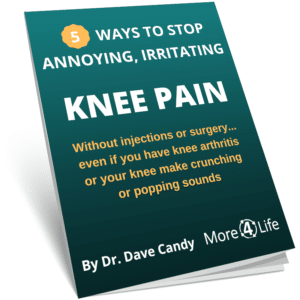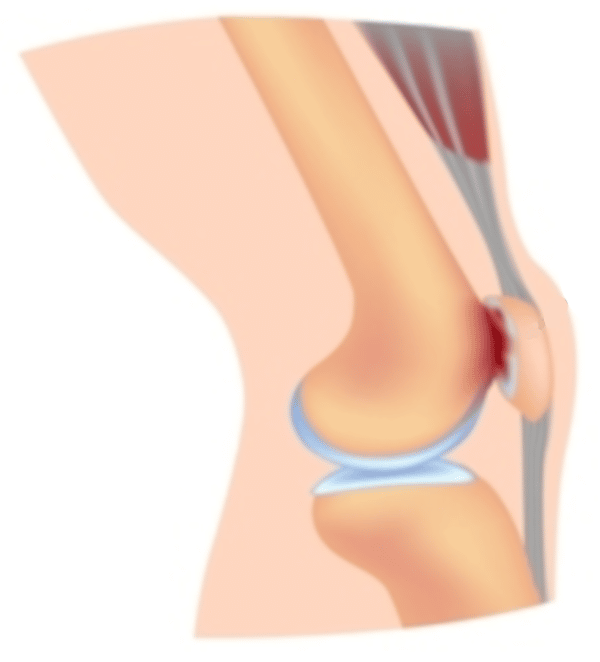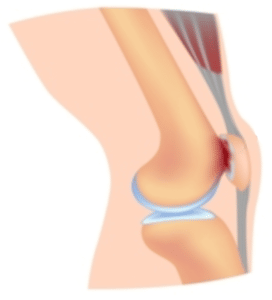If you've recently been diagnosed with chondromalacia in your knee, you may want to learn more about what chondromalacia patella is, if it's serious, and what treatments can help. In this post I'll explain all about chondromalacia in the knee and give you the some of the best exercise for chondromalacia patella.
What Is Chondromalacia?
Chondromalacia patella is a condition that affects the knee joint. More specifically, it affects the patellofemoral joint (the joint between the kneecap and the thigh).
It's a mild form of knee arthritis that results in the deterioration of the cartilage that covers the knee joint. This can lead to pain and swelling in the knee joint.

What Are The Symptoms Of Chondromalacia Patella?
The most common symptom of chondromalacia is pain on the front of the knee.
The pain is usually worse when you're active, such as when you're walking or running.
Other activities that may increase chondromalacia patella symptoms include:
The pain may also be worse when you sit for long periods of time with your knees bent, such as when you are driving.
Other symptoms of chondromalacia patella include:
- Swelling in the knee
- A popping, grating, or creaking sound when the knee is moved
- Difficulty bending and straightening the knee
Is Chondromalacia Serious?
Chondromalacia patella is not usually a serious condition. However, it can lead to more serious problems if it is not treated.
Chondromalacia is caused by a mechanical issue of the kneecap not being aligned correctly, or having too much compression against the thigh bone.
Over time, this can gradually wear down the cartilage in the knee more causing higher grades of arthritis.
What are the grades of chondromalacia?
- Grade 1 - slight softening of the cartilage behind the kneecap
- Grade 2 - the cartilage in the kneecap starts to wear down
- Grade 3 - the cartilage thins more and the joint space behind the kneecap starts to narrow
- Grade 4 - the cartilage wears all the way down causing "bone-on-bone" behind the kneecap.
Will I Need Surgery For Chondromalacia Patella?
Rarely do people need surgery for chondromalaica patella. Only in cases of extreme cartilage loss (Grade 4) in the kneecap would you possibly need surgery.
As with most things, the quicker you address a problem, the less of a chance it will get worse.
What Is The Treatment For Chondromalacia Patella?
The first line of treatment for chondromalacia patella includes nonsurgical options such as:
- RICE (rest, ice, compression, elevation)
- Physical therapy
- Bracing
Exercises For Chondromalacia Patella
Exercise is an important part of treatment for chondromalacia patella. Exercise can help to strengthen the muscles around the knee and improve range of motion.
It's best to start exercises for chondromalacia patella under the guidance of a physical therapist. Your physical therapist can help you to create an exercise program that is right for you.
However, here are some general exercises to get you started
Stretching exercises for chondromalacia patella
Stretching your quads and hip flexors is helpful because your patella sits inside of your quadriceps muscles. If the quadriceps muscles are stiff, then it creates more compression of the patella (kneecap) on the femur (thigh bone) as you bend your knee.
Stretching your calves also helps chondromalacia because if your ankle joint can't bend as you walk, run, or go down stairs, it causes your foot to overpronate and your knee to turn in. This in turn puts the patella in poor alignment.
Strengthening exercises for your hips
Strengthening your hip muscles is good for chondromalacia because your hip muscles control the side-to-side motion of your knees, especially your gluteus medius and gluteus minimus muscles. Exercises such as balancing on one leg, and clamshells can help to strengthen these muscles.
Additionally, your gluteus maximus muscle help keep you from using too much force from quadriceps. Squats and lunges are great exercises to strengthen both your gluteus maximus and gluteus medius/minimus, along with your quadriceps.
Don't forget the cardio
Low impact cardiovascular exercise is important when treating cartilage problems.
Articular cartilage like the kind behind your kneecap doesn't have a good blood supply. It actually gets it's bloodflow and nutrition from the bone underneath of it.
When you get gentle compression and distraction of the joint surfaces during movement, blood diffuses into the the cartilage.
That's why aerobic exercise like walking, biking, or using an elliptical trainer is so important for cartilage health.
To learn more exercises for chondromalacia patella, read our post about the 4 Best Kinds Of Exercise For Knee Pain.
What Is The Best Knee Brace For Chondromalacia Patella?
A knee brace for chondromalacia patella should hold the kneecap centered in the groove of the femur.
The BraceAbility patellar knee brace is good for people with chondromalacia in their knee. The C-shaped pad in the picture helps hold the kneecap in the proper position.
While I really like this brace, the picture above from amazon actually shows the brace on upside down. The C-shaped pad should go on the outside of the knee.
How Can I Prevent Chondromalacia Patella?
There are some things that you can do to help prevent chondromalacia patella.
These include:
- Warming up properly before exercise
- Using proper form when exercising
- Avoiding high-impact activities
- Stretching after exercise
- Wearing shoes that fit properly and provide arch support
- Using orthotics to prevent overpronation
Need Help For Knee Pain?
Tap the button below request an appointment with one of our specialist physical therapists.
Not Ready To Talk Yet?
Download our FREE Guide called "5 Ways To Stop Annoying, Irritating Knee Pain"







